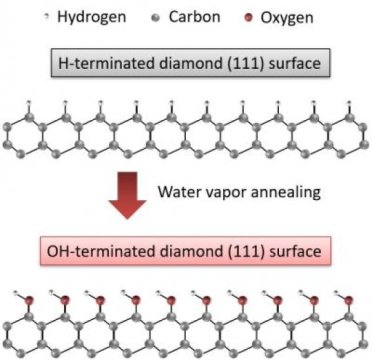Diamond surface water vapor annealing technology for next generation power devices
Diamonds are highly sought after for their dazzling beauty and are often presented in fine jewelry. However, this solid carbon is also known for its excellent physical and electronic properties. In Japan, researchers at the Graduate School of Natural Science and Technology of Kanazawa University and AIST of Tsukuba, led by Kyo Yoshida, used water vapor annealing to form an atomic-level flat hydroxyl-terminated diamond surface. Diamond has many features that make it attractive for use in electronic power supplies. However, while the naked eye looks perfect, diamonds contain defects that are observable at the atomic level, which create unique surface characteristics that affect how it is used in the device. In order to stabilize the diamond structure, surface termination using oxygen or hydrogen is used. The hydrogen terminated (H-terminated) diamond surface contains a two-dimensional hole gas layer (2DHG) for high temperature and high pressure operation. The oxygen-terminated diamond surface is formed by surface oxidation of the H-terminated surface, which removes hydrocarbon (CH) bonds and 2DHG, "but this can make the diamond surface rough and cause device performance degradation," Norio Tokuda said. Kanazawa University. To overcome this problem, the researchers applied a water vapor annealing process. They start with a (111) oriented high pressure, high temperature synthetic single crystal diamond Ib and IIa substrate. A homoepitaxial diamond film is grown on the Ib substrate by microwave plasma chemical vapor deposition (MPCVD). To obtain an atomically flat H-terminated surface, the diamond sample was exposed to an H-plasma in an MPCVD chamber. To form a hydroxyl terminated surface, the H-terminated diamond sample was subjected to water vapor annealing. The annealing treatment was performed by ultrapure water in a quartz tube in an electric furnace under a nitrogen atmosphere. The results show that during the steam annealing process below 400 ° C, the CH bond remains on the diamond surface; therefore, 2DHG is detected. “However, water vapor annealing above 500°C removes the CH bond on the diamond surface,†Yoshida explained, “indicating that 2DHG has disappeared.†Thus, the results indicate that water vapor annealing can remove 2DHG while maintaining the surface morphology of the (111) oriented diamond surface. "Compared to conventional techniques for removing 2DHG, such as wet chemical oxidation," Tokuda said, "water vapor annealing provides the advantage of maintaining an atomic-level flat surface." Plastic Profiles,Custom Made Plastic Molds,Variety Material Plastic Parts,Injection Molded Plastic Parts Ningbo Yongsheng Rubber And Plastic Products Co., Ltd. , https://www.yscnrubber.com